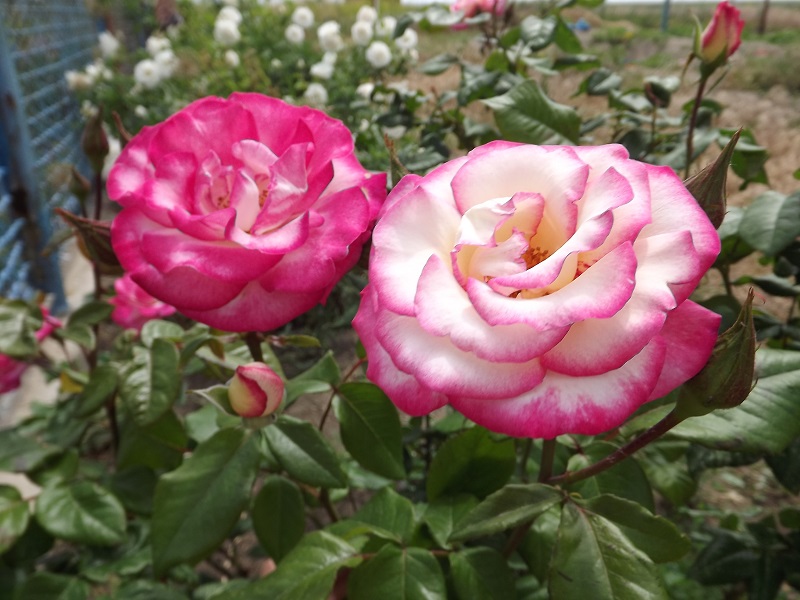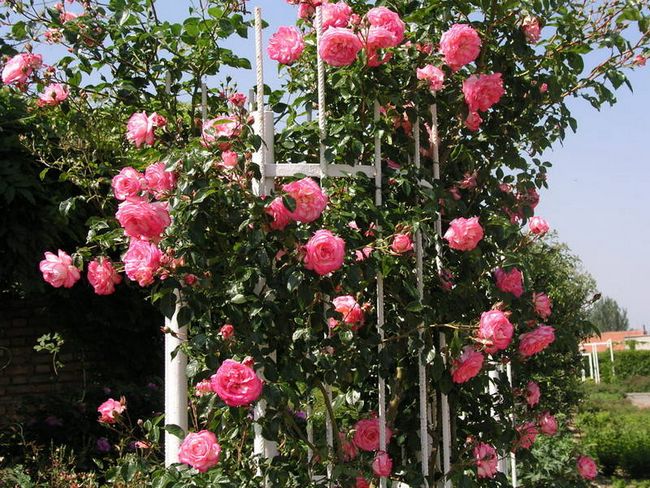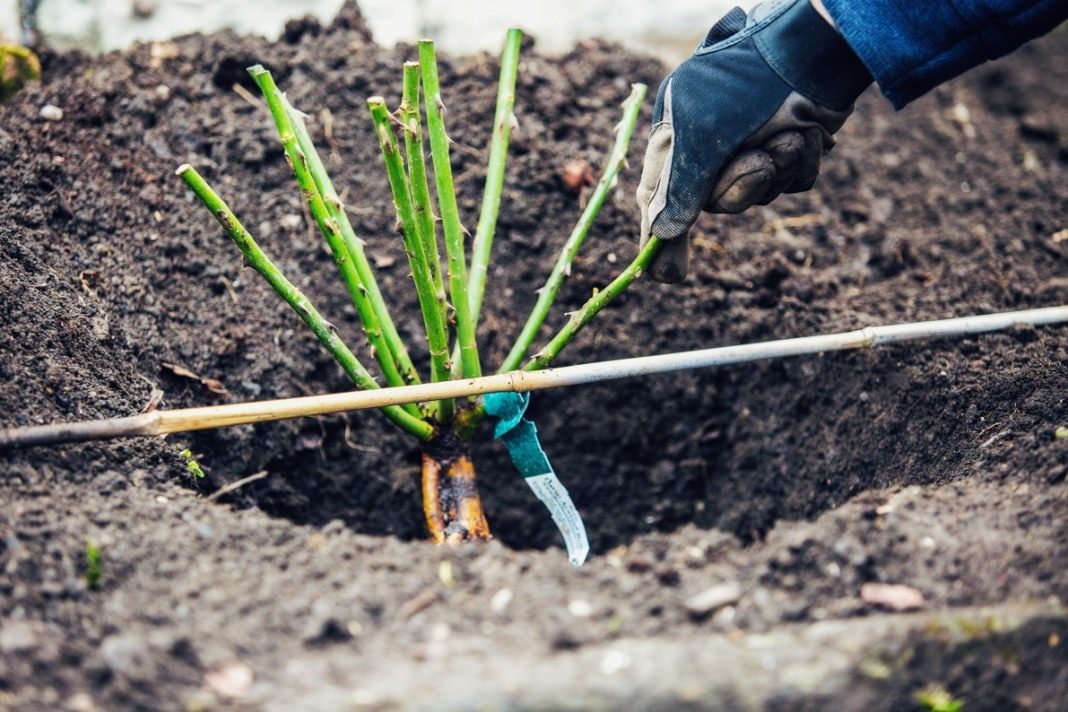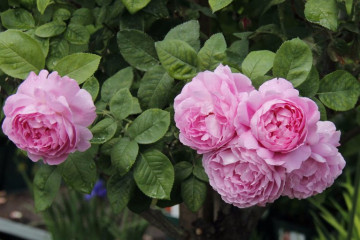Rose Handel (Handel) - features of planting and care
Content:
Rosa Hendel is a climbing culture that is often used in landscaping. She is white with a pink border. The culture is slow growing, but constantly releases new shoots. The indisputable advantage of the plant is its resistance to frost.
Rose Handel - what is this variety, history of creation
This variety was developed in Ireland in the early sixties of the last century. The rose got its name in honor of the famous composer G.F. Handel.
According to the description for the climbing rose Hendel, the original color is characteristic. It has white or cream petals with a pink or crimson border. The plant develops rather slowly, but periodically releases new shoots. Double flowers reach 8-10 cm in diameter. They have practically no aroma.
Flowering is observed 2 times a year. Moreover, the second wave is less abundant. Bushes are covered with inflorescences from July to October. The first wave lasts 1.5 months, followed by a break.
The bushes reach impressive sizes - 3.5-4 m. Their width is 2 m. The plant is characterized by tough shoots and rich green leaves.
Each branch is decorated with 3-9 buds. When they open up, the bright border seems thin enough. However, it expands over time.
Advantages and disadvantages of the variety
Rose Handel has a number of advantages:
- change in color of buds at different stages of flowering;
- long flowering period;
- thick and dense leaves;
- ease of reproduction.
At the same time, the culture differs in certain disadvantages:
- risk of sunburn;
- low resistance to fungal infections;
- the need for support;
- intolerance to prolonged rainfall.
In general, gardeners note that the positive characteristics of the variety somewhat prevail over the negative aspects.
Use in landscape design
Rose Hendel should not grow near fruit trees, as this increases the risk of infection with pathologies and parasites. The sophisticated combination of white and crimson border requires careful selection of complements.
Avoid planting brightly colored plants nearby. White, pink, or blue perennials are an excellent option. Low coniferous crops look attractive.
Growing a flower, how to plant it in open ground
In order for rose Hendel to grow and develop normally, she needs to provide full and high-quality care. The correct execution of planting works is of great importance.
The rose can be propagated with ready-made seedlings. They should be purchased at the nursery. It is also permissible to independently prepare and root the cuttings. However, this option is considered more time consuming.
It is recommended to plant a rose in early May. If the plant was bought in a greenhouse, it is worth postponing the planting until the leaves appear on the trees. It is important that the soil warms up to +10 degrees.Otherwise, there is a threat of death of the plant.
It is not recommended to plant the plant in a draft or in a place that is too sunny. The rose needs morning sun and a little breeze. In the afternoon, she should be in the shade.
How to prepare the soil and flower for planting
To prepare a crop for planting, it is necessary to provide it with high-quality drainage and light fertile soil. It is recommended to add mineral fertilizers and organic matter to the planting recess.
Planting procedure step by step
When planting a crop, you must do the following:
- Make a 60 cm depression.
- Place a mineral supplement at the bottom.
- Place the seedling in the hole so that the roots lie loose.
- Cover the gaps with earth.
- Tamp the soil. For this, summer residents often stomp on it with their feet.
- Drizzle with warm water - you will need about 5 liters.
- In cold weather, cover the rose with foil.
Plant care
In order for the plant to develop normally and bloom profusely, it needs high-quality care.
- Watering rules and humidity
The bushes need to be moistened 2-3 times a week. The specific amount of irrigation depends on the amount of precipitation and air temperature.
- Top dressing and soil quality
In August, it is recommended to add potassium salt and wood ash. It is also acceptable to use potassium sulfate.
- Pruning and replanting
With the onset of spring, it is recommended to prune the rose. To do this, remove damaged branches and shorten the growth to 4 buds. In the fall, it is worth removing dried and diseased branches.
- Features of wintering a flower
Climbing roses need to be covered with high quality for the winter. It is recommended to remove the adult plant from the support, wrap it with twine and place it on the ground.
Cover the branches with spruce branches or leaves from above. Covering material can also be used.
Blooming rose
The rose is characterized by abundant flowering. Thanks to this, the culture is actively used to decorate the site.
The rose bloom lasts from July to October. The buds on the same plant are at different stages of opening, which increases the decorative effect of the culture. In cold weather, the flowers lose their rich color. Under the influence of high temperatures, the rose takes on a raspberry hue.
During the flowering period, the plant does not need fertilization. In this case, it is necessary to adjust the amount of watering. The timely fight against parasites is of no small importance.
What to do if it does not bloom, possible reasons
There is no flowering, it is worth paying attention to the implementation of agrotechnical recommendations. Problems can be associated with such factors:
- lack of sun;
- aging of the bush;
- care disorders;
- root growth.
Flower propagation
It is recommended to propagate the rose by cuttings. In this case, certain features must be taken into account.
Harvesting cuttings is best done in early July.
To propagate the culture, you need to cut the cuttings from the middle of the stem. They must have at least 5 buds. The cut must be done at an angle of 45 degrees. Processed cuttings should be planted and with the help of a jar create a greenhouse - this will help maintain the necessary moisture.
Diseases, pests and ways to control them
Bushes often suffer from black spot. In this case, it is worth treating the plant with copper sulfate.
Insecticidal preparations will protect against pests. During flowering, the bush should be systematically examined, and when the first signs of problems appear, immediately take effective measures to eliminate pests or treat the bush.
The rose of this variety has excellent decorative qualities. Therefore, it is often used to decorate a site. To succeed in growing a crop, it needs to provide complete and high-quality care.



















